Differences Between Hybrid Care and Nurse Home Visit Programs
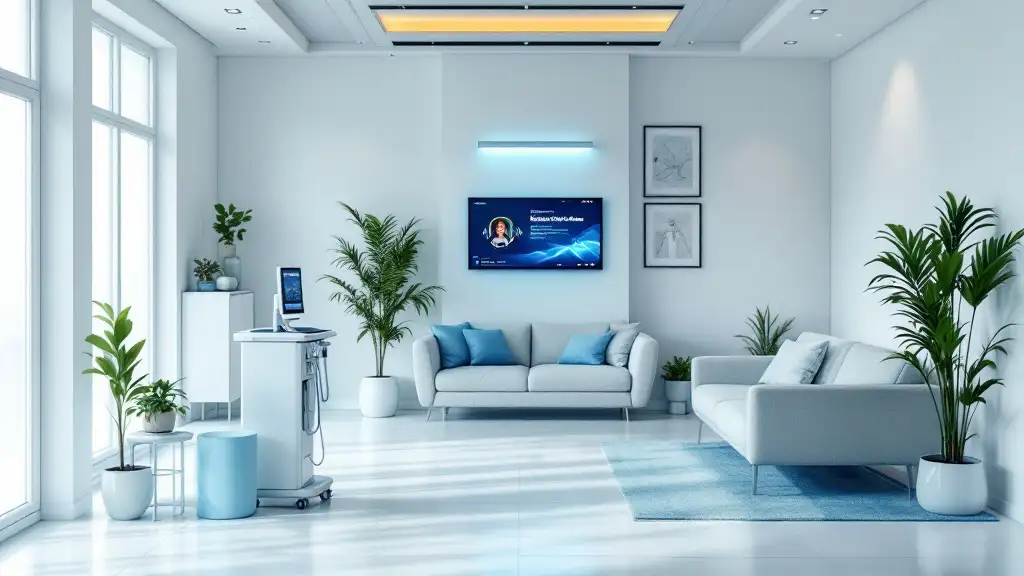
Understanding Modern Healthcare Delivery Approaches
As healthcare systems evolve to meet diverse patient needs and improve outcomes, two prominent models have emerged: hybrid care programs and nurse home visit strategies. While both aim to enhance care accessibility, quality, and effectiveness, their structures, implementation, and scope differ significantly. This article explores these differences in detail, providing insight into how each model functions, their advantages, and the contexts in which they are most effective.
Defining Hybrid Care and Nurse Home Visit Programs
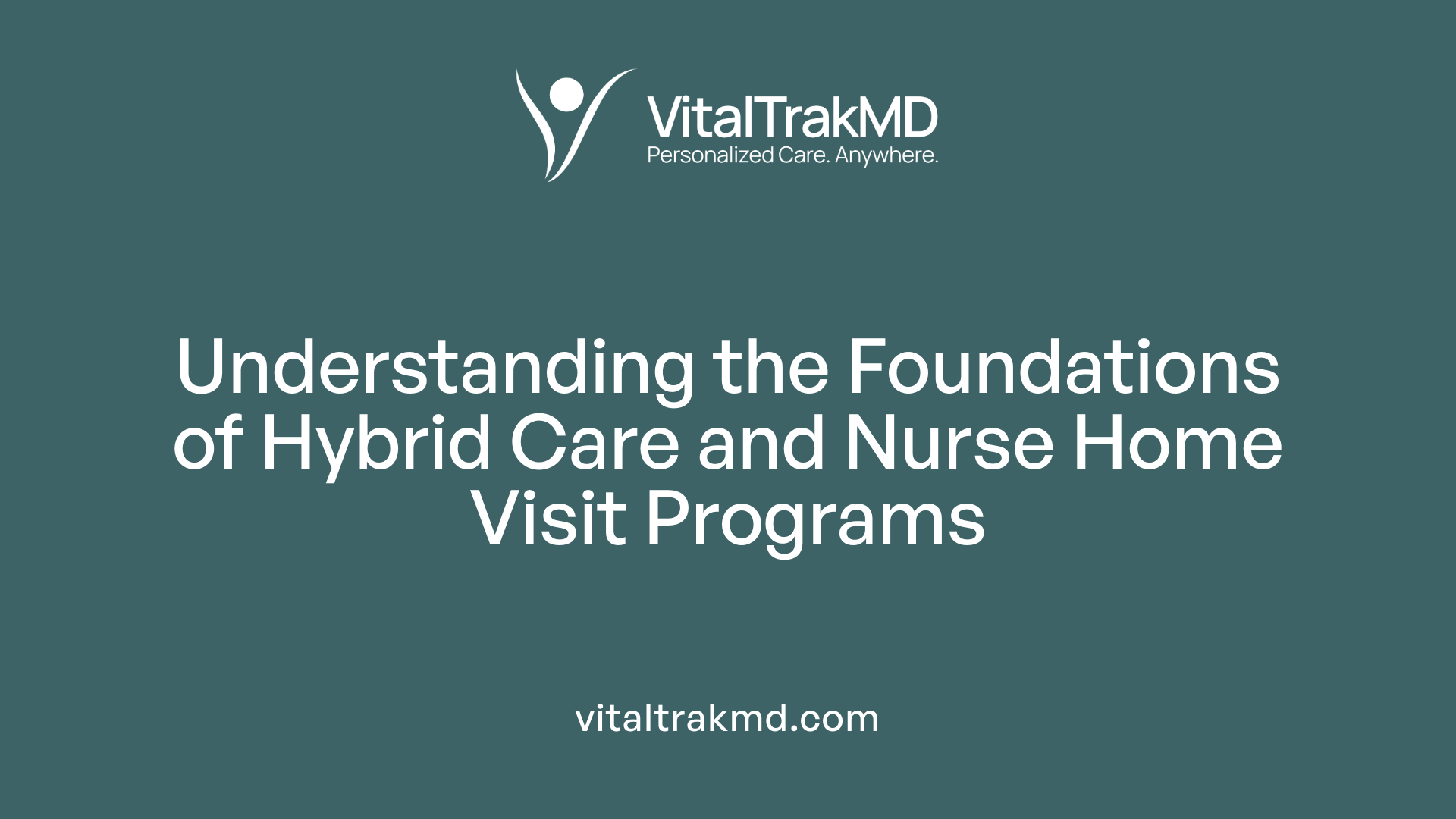
What are the fundamental differences between hybrid care models and nurse home visit programs?
Hybrid care models and nurse home visit programs serve different roles within healthcare delivery, although they often aim to improve patient access and outcomes.
Hybrid care combines multiple modes of healthcare delivery. This includes virtual consultations, remote patient monitoring, in-home visits, and sometimes virtual hospital components such as command centers. These models are designed to be flexible and adaptable, catering to diverse patient needs across different settings, including urban and rural environments.
For example, the Mayo Clinic’s Advanced Care at Home (ACH) program exemplifies this approach. It integrates a virtual command center with in-home care, supporting complex diagnoses and providing continuous monitoring. This enables rapid escalation of care, virtual evaluations, and coordination with emergency services when needed.
In contrast, nurse home visit programs focus mainly on direct, in-person interactions. These involve healthcare professionals, usually nurses or advanced practice providers, visiting patients' homes for assessments, treatments, and ongoing care management.
Providence’s at-home care strategy highlights this model. It emphasizes remote patient monitoring but also includes in-person visits for medication management, education, and engagement, especially for patients with chronic illnesses like hypertension and heart failure.
| Aspect | Hybrid Care Model | Nurse Home Visit Program | Example |
|---|---|---|---|
| Scope of services | Multiple, including telehealth, remote monitoring, in-home visits, virtual centers | Primarily in-person, face-to-face assessments | Mayo Clinic’s ACH |
| Delivery methods | Combining virtual platforms, digital tools, in-home visits, and virtual hospital components | Home visits by nurses/providers | OSF HealthCare’s digital hospital-at-home |
| Focus areas | Chronic disease management, acute care escalation, post-acute recovery | Post-discharge care, chronic care, low mobility needs | Providence’s hypertension and heart failure programs |
The differences highlight how hybrid models aim to create a comprehensive, coordinated care system utilizing advanced technology and multiple touchpoints. Meanwhile, nurse home visits concentrate on personalized, direct care, often for specific populations or purposes.
Both approaches have their strengths, and in many cases, they can complement each other. Hybrid care expands reach and efficiency, while nurse visits provide essential in-person assessments and interventions, especially critical for vulnerable patients or those requiring hands-on care.
Understanding these distinctions helps healthcare systems tailor their strategies to meet diverse patient needs and improve outcomes effectively.
Structural Features and Components
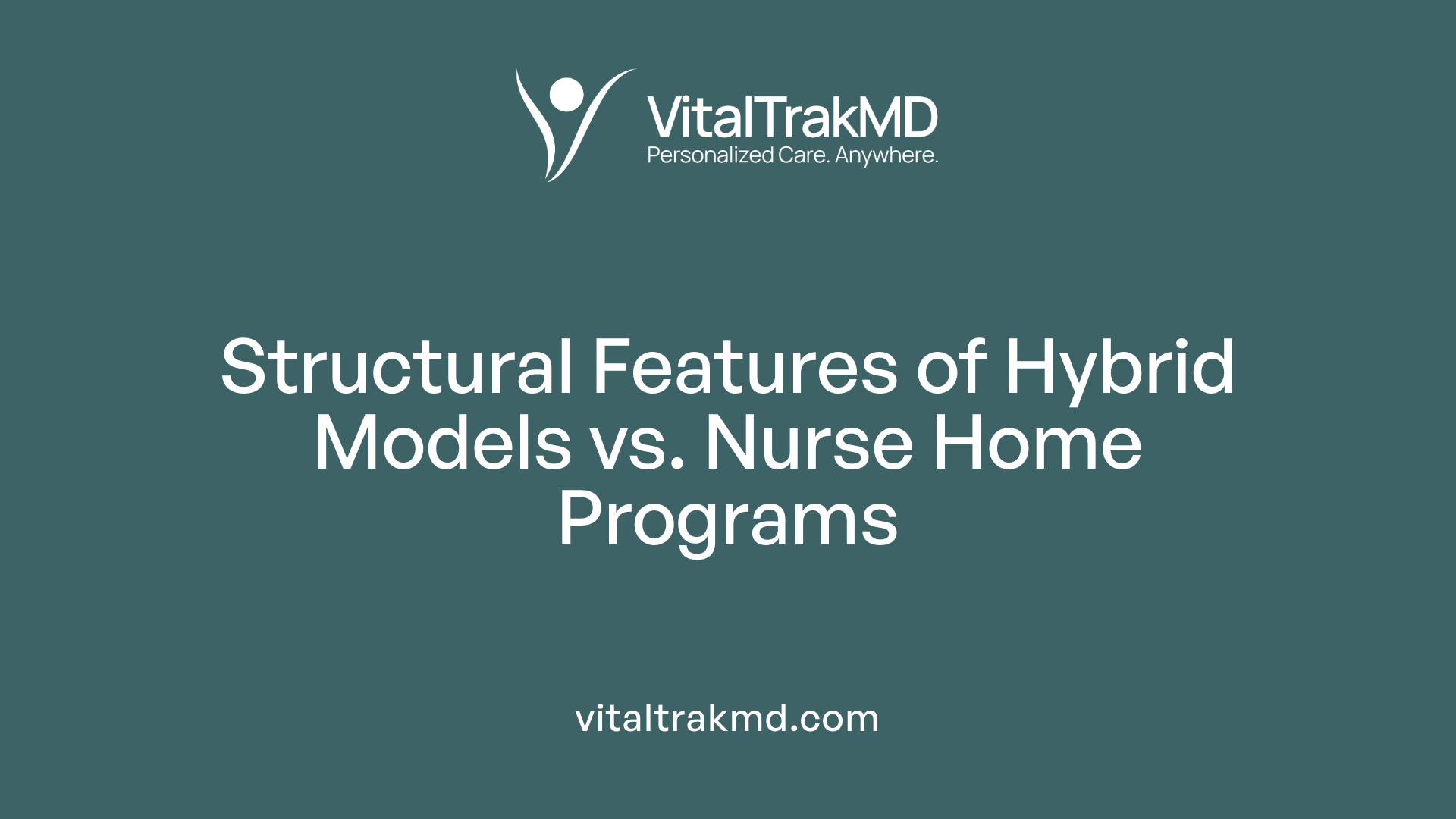
How do the features, benefits, and structures of hybrid care compare to those of nurse home visiting programs?
Hybrid care combines the flexibility of telehealth with traditional in-person healthcare services, creating a versatile model for patient management. It typically involves virtual consultations conducted through voice or video platforms, remote monitoring of vital signs, and occasional face-to-face visits when necessary. This structure allows healthcare providers to monitor multiple aspects of a patient’s health efficiently, often using technology such as virtual command centers and remote monitoring devices. For example, Mayo Clinic’s Advanced Care at Home (ACH) program leverages a virtual command center to coordinate care across urban and rural settings, deploying in-home visits by advanced practice providers and virtual evaluation as needed.
In contrast, nurse home visiting programs are more focused on in-home assessments and direct interventions. These programs often involve healthcare professionals, such as nurses, visiting patients’ homes for personalized care, especially targeting populations like new mothers, children, or patients with chronic illnesses. The visits typically include physical assessments, health education, and support tailored to individual patient needs. OSF HealthCare’s digital hospital-at-home initiative exemplifies this approach, deploying nurses and caregivers with in-home services complemented by virtual checks.
Technology and communication platforms in hybrid care facilitate continuous monitoring and virtual engagement, reducing the need for frequent physical visits. These platforms support telehealth consultations, medication management, and health education, thus improving access and convenience. Providence’s program, for instance, reported a 30% reduction in blood pressure levels within a year using remote monitoring for hypertension patients.
In-person assessments and interventions in nurse home visits are crucial for comprehensive evaluations that require physical presence, such as wound care, complex medication administration, or assessments of mobility and environment safety. These visits are also instrumental for high-risk or frail patients, who benefit from the personalized, relationship-based care in their home environment.
The use of virtual command centers and remote monitoring enhances patient safety and responsiveness in both models. The Mayo Clinic ACH program’s virtual command center allows for rapid escalation of care during acute deterioration, deploying community paramedics or emergency services if necessary. Providence’s approach utilizing remote blood pressure and glucose monitoring evidences the effectiveness of integrating real-time data with clinical decision-making.
Below is a comparison table illustrating the differentiating features:
| Aspect | Hybrid Care | Nurse Home Visiting Programs |
|---|---|---|
| Delivery Method | Combines telehealth and in-person visits | Primarily in-home, face-to-face interactions |
| Technology Use | Extensive (remote monitoring, virtual command centers) | Limited, primarily for documentation and communication |
| Patient Focus | Broader, often chronic disease management | Specific populations, such as new mothers, chronic disease patients |
| Flexibility | High, adaptable based on patient needs | Lower, structured schedules and protocols |
| Typical Duration of Care | Ongoing, supports long-term monitoring | Often intensive over a set period, especially early in care |
| Costs & Resources | Potentially lower due to reduced in-person visits | Can be resource-intensive with frequent home visits |
| Examples | Mayo Clinic ACH, Providence remote monitoring | OSF HealthCare, home-based post-discharge support |
Overall, hybrid models expand traditional care through technology, offering a scalable, flexible approach that can be tailored for various health conditions and settings. Nurse home visiting programs, on the other hand, deliver personalized, hands-on care, essential for certain vulnerable groups. Both aim to enhance health outcomes, but with different structures and operational emphases.
Delivery Methods and Effectiveness
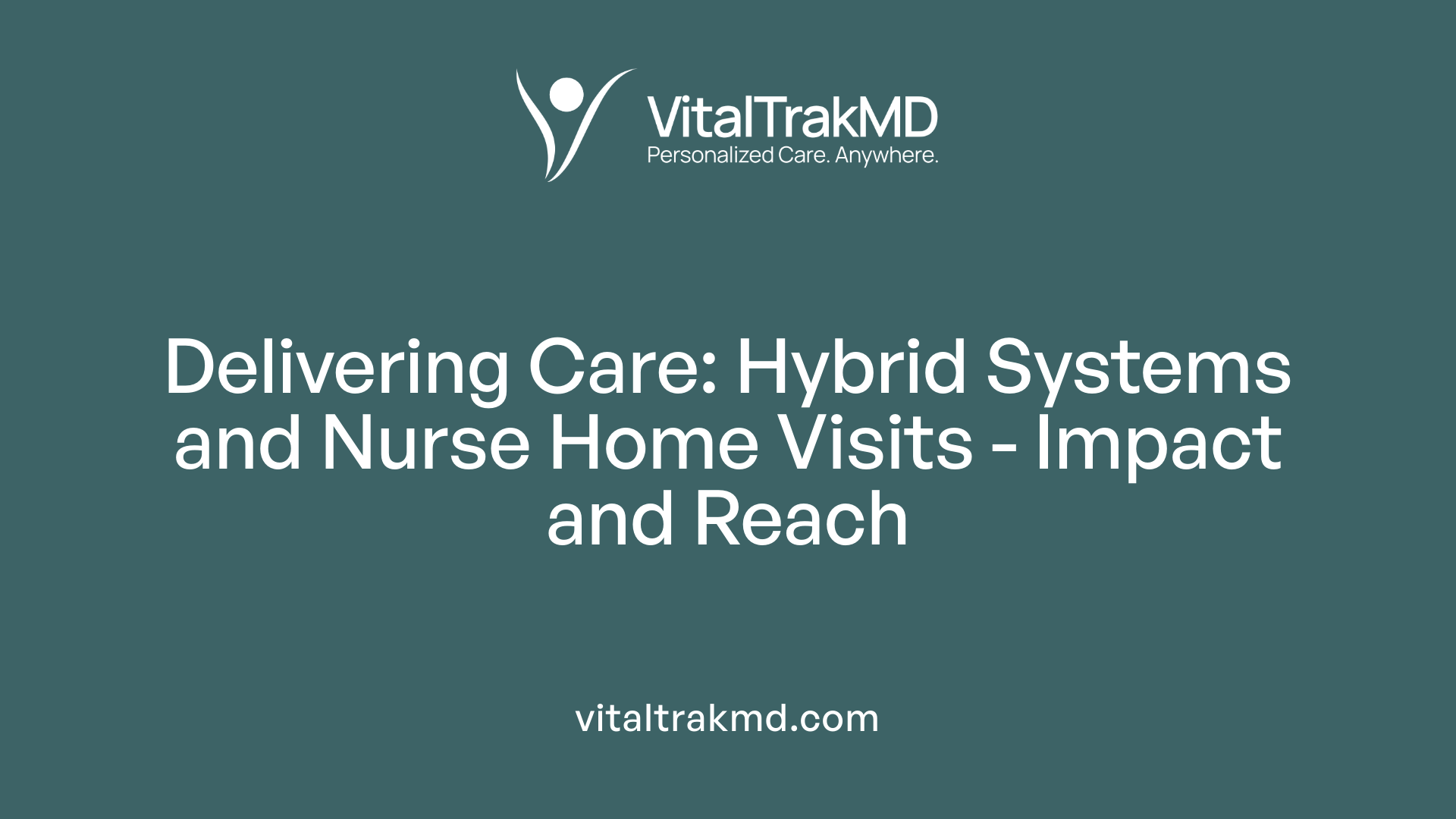
How do hybrid care models and nurse home visits differ in scope and impact?
Hybrid care delivery combines various modes such as telehealth, remote monitoring, and in-person services to create flexible, accessible healthcare solutions. These models leverage technology to provide virtual consultations, continuous patient monitoring, and occasional face-to-face interactions, making healthcare more convenient—especially for populations like older adults or those with chronic conditions.
Nurse home visits focus on direct in-home assessments and interventions by healthcare professionals. This traditional approach enables personalized, thorough examinations and immediate responses to patient needs. It is particularly effective for post-discharge follow-up, managing chronic illnesses, and helping patients with mobility issues.
In terms of scope, hybrid care encompasses a broader range of activities by integrating virtual care with in-person support. This allows healthcare providers to manage larger patient populations efficiently without sacrificing quality.
Effectiveness-wise, hybrid models have demonstrated improvements in health outcomes, including reduced hospital readmissions and better disease management. For example, programs that incorporate telehealth and remote monitoring have shown significant reductions in blood pressure among hypertensive patients and increased adherence to treatment plans for congestive heart failure.
While nurse home visits provide intensive, personalized care that can lead to excellent outcomes in specific cases, they tend to be more resource-consuming and less scalable. In contrast, hybrid care extends reach and can adapt to various clinical needs, often matching or surpassing the effectiveness of traditional home visits.
How do these approaches enhance patient accessibility and clinical results?
Hybrid care models improve access by removing barriers such as transportation or mobility issues. Patients can receive timely virtual consultations or continuous monitoring from home, reducing delays in treatment. These models support early detection of health issues and enable rapid intervention, which can prevent complications.
Clinical outcomes in hybrid models, such as lower readmission rates and better chronic disease control, support their effectiveness. For instance, Providence’s remote monitoring program has achieved a 30% reduction in blood pressure and a 55% increase in patients on comprehensive care regimens for heart failure.
Nurse home visits deliver high-quality, personalized care directly into the home, vital for vulnerable populations needing close supervision. This approach ensures that subtle health changes are identified early, leading to swift action.
Comparing resource utilization and reach
Hybrid care is often more resource-efficient. It minimizes the need for continuous in-person staffing, reduces hospital stays, and allows care teams to serve more patients simultaneously. This scalability is essential for addressing broader healthcare needs.
Nurse home visits, while highly effective for individual needs, involve significant staffing and logistical expenses. They typically serve a smaller patient cohort due to resource constraints.
| Aspect | Hybrid Care | Nurse Home Visits | Additional Details |
|---|---|---|---|
| Scope | Combines telehealth, remote monitoring, occasional in-home visits | In-person assessments and interventions | Hybrid models manage large patient volumes with digital tools; home visits offer intensive personalized care |
| Accessibility | Higher, due to remote access, platform flexibility | Limited by patient mobility and geography | Allows for daily virtual check-ins versus weekly or monthly visits |
| Outcomes | Reduced hospital readmissions, better chronic management | Personalized, potentially higher satisfaction | Outcomes depend on patient needs; hybrid tends to improve system efficiency |
| Resource Use | Lower overall, scalable, cost-effective | Higher per-patient, resource-intensive | Hybrid models optimize staffing and technology use |
Final thoughts
Both hybrid care and nurse home visits serve critical roles in modern healthcare. While nurse home visits excel in delivering detailed, individualized attention, hybrid models enhance reach, efficiency, and often uniformly improve outcomes. Combining elements of both may offer the most balanced approach to patient-centered care, optimizing resource use while maintaining high-quality, accessible healthcare offerings.
Characteristics, Functions, and Real-World Applications
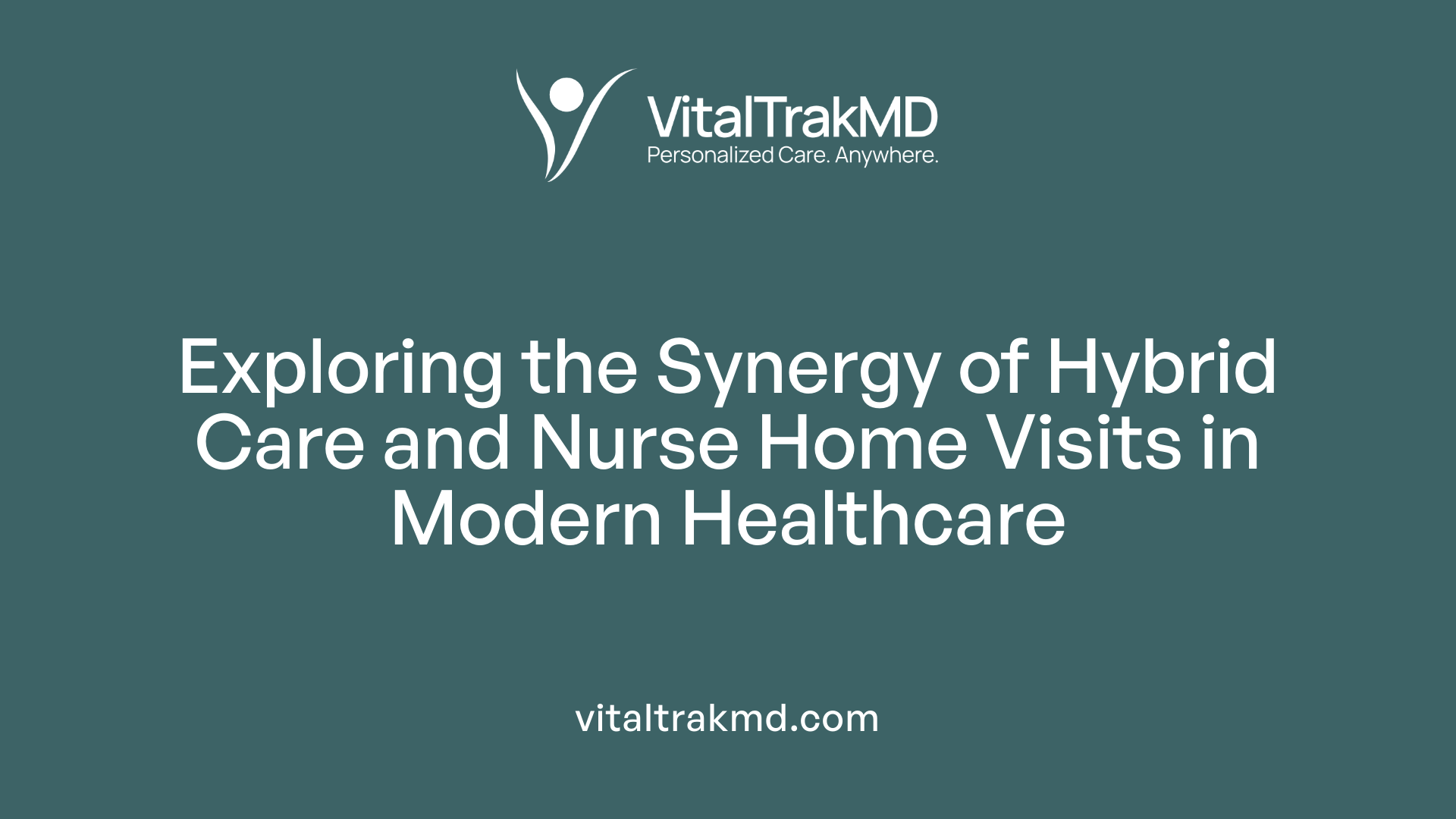
How do the characteristics and functions of hybrid healthcare delivery models compare to nurse home visit strategies?
Hybrid healthcare delivery models integrate multiple methods of care delivery, including telehealth, remote monitoring, and in-person services, creating a flexible and comprehensive approach. These systems allow patients to easily switch between virtual consultations with providers and in-home care, which improves access and care continuity.
For example, the Mayo Clinic’s Advanced Care at Home (ACH) program uses a virtual command center that coordinates both telehealth consultations and in-home visits by advanced practice providers. This setup supports patients with conditions like pneumonia, septicemia, or congestive heart failure, reducing hospital stay length and lowering the risk of readmission. The hybrid model’s ability to escalate care rapidly during emergencies, such as virtual evaluations combined with deploying community paramedics, exemplifies its dynamic and responsive nature.
In contrast, nurse home visits focus primarily on direct, face-to-face interactions. Nurses or care technicians are dispatched to the patient’s home to perform assessments, medication management, and basic clinical interventions. These visits are especially beneficial for chronic disease management, post-discharge care, and for patients with mobility issues or those in rural areas.
While hybrid models leverage technology like voice and video telehealth tools to connect providers with patients remotely, nurse home visit programs emphasize in-person assessments. Both approaches aim to improve health outcomes by providing care where patients live, but they differ mainly in scope and delivery.
| Aspect | Hybrid Care Models | Nurse Home Visits | Additional Details |
|---|---|---|---|
| Care Methods | Telehealth, remote monitoring, in-person visits | Direct in-home visits by healthcare professionals | Hybrid combines tech and physical visits; nurse visits are solely physical |
| Flexibility | High; adaptable to various patient needs and emergencies | Focused on specific clinical interventions in the home | Hybrid can be scaled across regions and conditions |
| Use Cases | Chronic disease management, hospital-at-home, emergency care | Post-discharge routines, low mobility patients | Both reduce hospital admissions and improve access |
| Technology Use | Telemedicine platforms, sensors, virtual communication | Minimal technology; primarily in-person assessments | Hybrid models heavily rely on tech; nurse visits prioritize close contact |
Examples of successful programs and outcomes
Mayo Clinic’s ACH Program:
- Enrolled 686 patients from 2020 to 2021.
- Most common diagnoses: pneumonia, septicemia, heart failure.
- Median acute stay: 3 days; median restorative stay: 22 days.
- Mortality rate in-program: 0%; 30-day: 0.6%; readmission: 9.7%, which is lower than traditional care.
- Features rapid escalation during deterioration, including virtual tools, community paramedics, and emergency response.
Providence’s Remote Monitoring Program:
- Focuses on patients with hypertension, diabetes, heart failure, and COPD.
- Achieved a 30% reduction in blood pressure and a 55% increase in patients on multiple heart failure therapies within 3 months.
- Led to decreased utilization of emergency and other acute services.
OSF HealthCare’s Digital Hospital-at-Home:
- Enrolled over 700 patients since August 2022.
- Low escalation rates (<10%) and no infections reported over two years.
- Uses virtual command centers and in-home caregivers for medication delivery, meals, and labs.
UMass Memorial’s Mobile Integrated Health:
- Conducts over 1,000 visits since 2021.
- Achieved approximately a 60% reduction in 30-day readmissions.
- Combines paramedic-led home care with ongoing coordination involving primary care and specialists.
How do hybrid care models and nurse home visit programs differ?
Hybrid care models are characterized by their multi-modal approach, combining telehealth, remote monitoring, and in-person visits within a structured system supported by technology. They are highly adaptable, suitable for managing broad patient populations, and are scalable, especially in urban and rural settings.
Nurse home visit programs, on the other hand, provide personalized, direct care focused on specific needs like medication reconciliation, wound care, or post-discharge assessment. These involve healthcare professionals physically visiting patients and are especially effective for individuals with complex or mobility-limiting health conditions.
Both models aim to enhance care quality, reduce hospital stays, and improve health outcomes. Hybrid systems excel in offering continuous, dynamic engagement across diverse settings, while nurse visit programs provide intensive in-person, customized care.
In conclusion, combining the flexibility and broad reach of hybrid healthcare delivery models with the personalized touch of nurse home visits can create a comprehensive, patient-centered health system that maximizes benefits for diverse patient groups.
Implementation, Benefits, and Key Differences
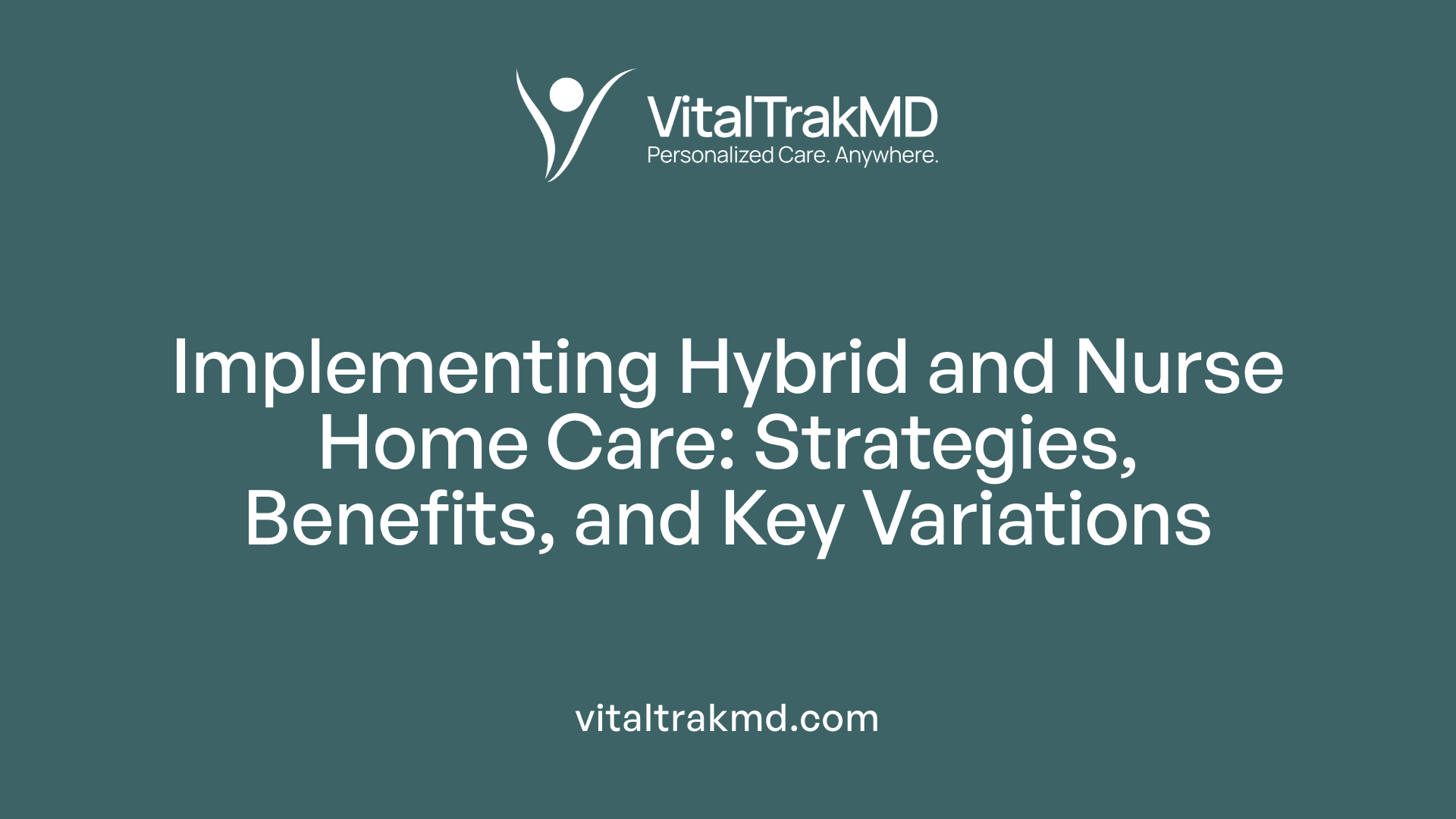
How are hybrid care programs operationally structured?
Hybrid care programs blend virtual and in-person healthcare services to maximize patient access and improve health outcomes. These programs typically rely on a virtual command center staffed with physicians and nurses who coordinate care across regions, including urban and rural settings. In-home visits by advanced practice providers and community paramedics complement telehealth consultations, ensuring comprehensive care.
For instance, the Mayo Clinic’s Advanced Care at Home (ACH) model utilizes technology and in-home services, supporting diagnoses like pneumonia or septicemia without immediate hospitalization. Enrolled patients benefit from regular virtual check-ins, in-person evaluations, and rapid escalation if their condition worsens.
Technological infrastructure, trained healthcare personnel, and care coordination platforms are fundamental to these programs. They utilize remote monitoring devices, virtual consultations via video or voice, and supply chain management to ensure timely delivery of medications and supplies.
What are the advantages of nurse home visits combined with telehealth?
Nurse home visits, integrated with telehealth, enhance care quality by enabling detailed assessments that are difficult to replicate remotely alone. Having a nurse present during telehealth consultations allows for thorough physical evaluations, medication management, and immediate intervention if needed.
This model improves patient engagement, especially for those with chronic illnesses like diabetes or congestive heart failure. For example, a diabetic patient receiving regular nurse visits and telehealth follow-ups was able to avoid frequent hospital stays, seeing a substantial positive impact on their health and quality of life.
In the post-acute phase, nurse visits focus on medication management, health education, and facilitating communication with primary care providers. The combination of face-to-face and virtual care encourages early detection of complications, reducing hospital admissions and readmissions.
How do hybrid and nurse home visit models differ, and what are their benefits?
While both models aim to improve healthcare delivery, their core differences lie in scope and implementation:
| Aspect | Hybrid Care Programs | Nurse Home Visit Strategies |
|---|---|---|
| Delivery Method | Combines telehealth, remote monitoring, and in-person visits | Primarily involves healthcare providers visiting the patient's home for assessments and interventions |
| Typical Use Cases | Acute and chronic care management, post-discharge follow-up | Chronic disease management, post-surgical recovery, low mobility patients |
| Technological Involvement | Heavy reliance on digital infrastructure, apps, telehealth platforms | Minimal technology, focus on direct face-to-face assessments |
| Patient Engagement | Enhances access via virtual visits & remote tools | Personalized bedside care and assessments in home |
| Scalability & Flexibility | High potential for scaling with proper infrastructure | More resource-intensive, tailored to individual needs |
Hybrid models benefit from rapid scalability, allowing physicians to reach more patients efficiently while maintaining high-quality care. They often lead to reduced hospital readmissions and improve patient outcomes.
Conversely, nurse home visits excel in delivering personalized care, especially for vulnerable populations, and foster community engagement. Both approaches complement each other, especially when integrated into comprehensive care strategies.
How are these programs sustained and scaled?
Sustainable hybrid programs depend on efficient resource management, including staffing, technology, and logistics. Proper training, robust care coordination systems, and flexible deployment of healthcare professionals ensure continuity and high standards of service.
Fostering provider engagement and maintaining autonomy are crucial. Providence’s program, for example, emphasizes clinician involvement to improve clinical metrics like blood pressure and medication adherence.
Cost reductions are notable, with programs reporting decreases in acute utilization, hospital costs, and outpatient visits. For instance, OSF’s digital hospital-at-home reported low escalation rates and no infections over two years, demonstrating safety and efficiency.
Scaling these models involves systematic evaluation of outcomes, investment in digital infrastructure, and community integration. Well-designed studies, such as those performed by Mayo Clinic, validate efficacy and inform best practices, paving the way for broader adoption.
Comparing outcomes and scalability potential
| Aspect | Hybrid Care Systems | Nurse Home Visit Strategies |
|---|---|---|
| Hospital readmission reduction | Up to 60% in some cases | Significant but often less quantifiable |
| Mortality rates | Very low (0-0.6%) in studied programs | Data varies, generally favorable |
| Patient satisfaction and engagement | High from telehealth flexibility | High due to personalized attention |
| Cost savings | Notable reductions in costs | Cost-effective for targeted populations |
| Implementation complexity | Moderate to high, requiring infrastructure | Moderate, depends on community resources |
These models show promising results in enhancing care quality, reducing costs, and expanding access. As digital health advances, the potential for scalable, sustainable hybrid care programs grows, transforming traditional healthcare delivery.
Understanding the operational intricacies, benefits, and differences between hybrid and nurse home visit care models is vital for healthcare providers and policymakers aiming to improve patient outcomes while managing resources effectively.
Summarizing the Key Differences and Future Directions
Hybrid care models and nurse home visit programs serve the overarching goal of enhancing care delivery, yet they do so through distinct frameworks suited to different contexts and needs. Hybrid care's multi-modal approach offers scalability, technological integration, and efficiency, making it adaptable across diverse healthcare environments. Conversely, nurse home visits provide intimate, personalized care tailored to individual patient circumstances, often in resource-limited settings. Both models hold promise for improving health systems' responsiveness, but understanding their unique features helps stakeholders tailor interventions for optimal outcomes. As healthcare continues to evolve, the synergy of these approaches—often combining their strengths—will likely shape the future of patient-centered, accessible, and effective care.
References
- Home-based, hybrid health care in rural communities
- Implementation of a virtual and in-person hybrid hospital-at ...
- How 3 Health Systems Are Scaling Hybrid & Home-Based ...
- Rapid synthesis: Optimizing the use of hybrid-care models ...
- Comparing In-Person Only, Telemedicine Only, and Hybrid ...
- What Is a Hybrid Care Model? How Virtual Nursing and ...
- The hospital at home in the USA: current status and future ...
- An overview of Hospital‐at‐home versus other models ...
Recent articles
Want to Feel Better and Live Healthier?
Join hundreds of patients taking control of their health with personalized care that fits their life – not the other way around.
Rated 4.8/5 by 32+ customers







